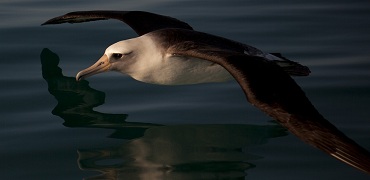570620-high flying deputy.JPG

Albatrosses are being used to track fishing vessels. Credit: Andy Collins/NOAA Office of National Marine Sanctuaries
An albatross is a perfect sentinel for watching the oceans. It’s big, it flies fast, and it can stay at sea for months, so it covers a large area. And it can sniff out fish from miles away. The combination could make the birds good deputies for tracking down illegal fishing operations.
Such operations catch billions of dollars’ worth of fish. They sometimes fish in protected areas, take more than the limit, or use equipment that can damage the environment. And when they do so, the operators often turn off the automated radio beacons that identify them.
Yet baitfish on their lines attract seabirds, which can get snagged and pulled under water to drown. That’s a special problem for the albatross, which can track down boats that are far out to sea.
But researchers recently attached trackers to 169 albatrosses in the southern Indian Ocean. In six months, the birds covered 20 million square miles.
A tracker “pinged” a satellite when it detected a radar beam. Researchers then checked to see whether the boat was broadcasting its ID signal. More than a quarter of the 353 boats detected were not. And in international waters, the number was more than a third. There’s a good chance that such boats were operating illegally.
Using albatrosses to track fishing vessels could reveal how widespread illegal fishing really is. And some day, it could help enforcement agencies catch illegal fishers in the act -- hunted down by long-range deputies.

